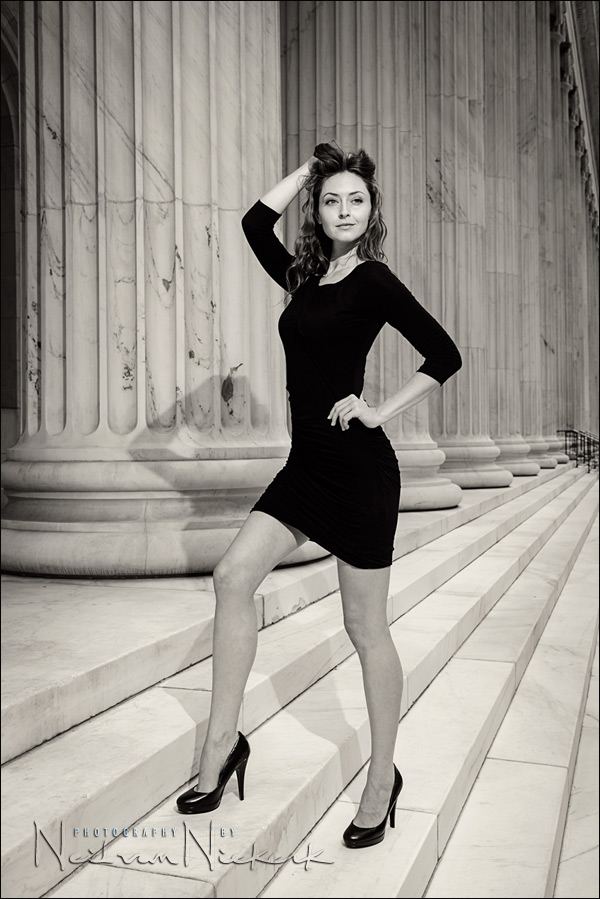
Flash photography tip – Adding flash to ambient light
When I saw the beautiful architecture of the Court House in Denver, CO, I knew that I wanted to use this as a backdrop for part of the mini photography workshop in Denver. In terms of composition, the imposing pillars and leading lines of the steps would simultaneously make a simple and classic background. Our model, Elizabeth, fortunately had this simple, yet elegant black dress as part of her wardrobe. For me, this photo comes together with the way the model (with her own style and styling), and the chosen location, complements each other.
That’s all a long way to say that I really like this image.
So while “having some kind of idea what you want to do” at the start of a photo session, is always a help, the success of any resulting photographs are most often a result of all the other choices coming together as well – posing, composition and lighting.
The composition is fairly straight-forward. But do notice that I shot slightly upwards towards her, to accentuate her legs. Shooting down would’ve created a strange fore-shortening effect. The focal length on the zoom lens was 38mm – wide-ish. If you’re photographing people with a wide lens, it is best to shoot from belly-button height with the camera – exactly where an old twin-lens reflex camera would’ve been held. This way you’re not shooting down, nor shooting up. So spatial distortion is minimized.
Then there’s also that touch of serendipity which brings some unexpected magic. In this image, her shadow was what helped pull the image together. Suddenly it isn’t just soft lighting – now it looks like a bit of sunshine sneaking through a thin layer of clouds. And the image pops!
To get that dramatic light on her, we used undiffused off camera flash. In other words – hard direct off-camera speedlight. Since this is a small light source, you have to be very specific in posing your subject. Posing “into the light” usually works best. You have to be careful though not to get weird shadows, but to have the light from the bare flash still be flattering.
The way the shadow fell behind her, was an accidental little bonus. I’ll take it when it comes.
The camera settings were: 1/250 @ f/5.6 @ 100 ISO … TTL flash, off-camera.
But let’s have a look at how we got to those settings:
Lighting & Design for Portrait Photography
Lighting & Design is a follow-up of sorts to Direction & Quality of Light. It’s a slightly eclectic mix, discussing the thought-process with various scenarios shooting portraits. The examples use available light, bounce flash, off-camera flash as well as studio lighting.
The idea is that in every one of the 60 sections, there is something to be learnt and applied, regardless of your level as a photographer or where you shoot – all shaped to form a cohesive narrative arc throughout the book.
You can either purchase a copy via Amazon USA or Amazon UK. The book will also available on the Apple iBook Store, and Amazon Kindle.
Now as much as photographers want to know the settings, I do feel that most often, there isn’t any real info in just the numbers, so let’s step through the decision making along the way. Just exactly how I chose those specific settings.
The next two images are versions at: 1/250 @ f/4 @ 100 ISO
1st image: TTL flash, off-camera. 2nd image: available light only.
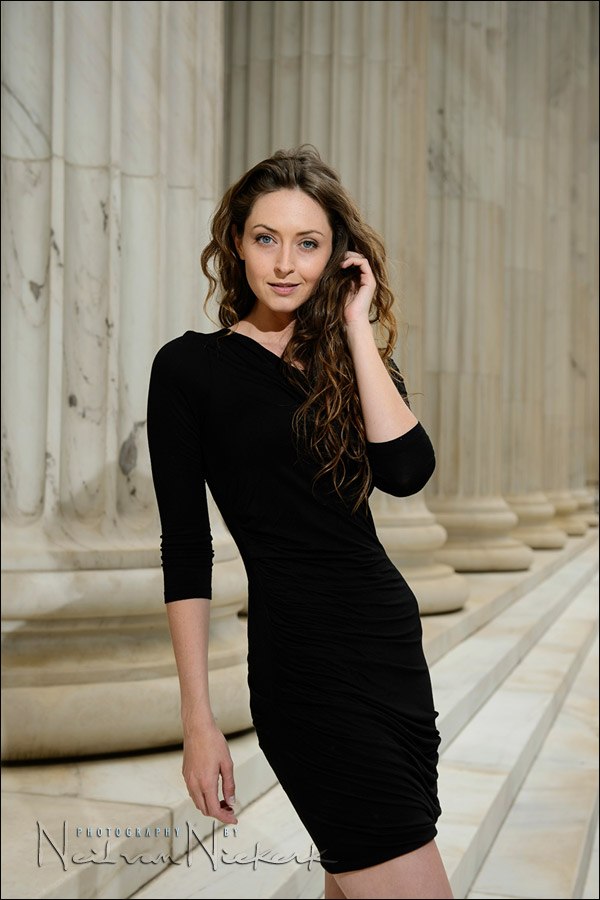
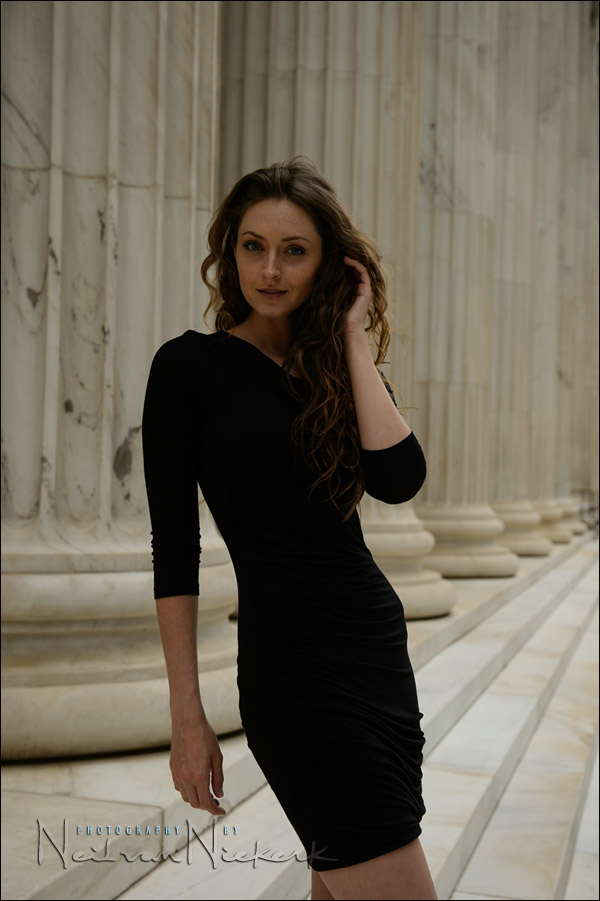
Deciding on specific camera and flash settings
In the previous two photos – why the change from f/4 to f/5.6 and how was the decision made?
Ultimately, the photographs look slightly different in terms of how the flash and ambient was balanced, but there’s no wrong or right.
Here’s a sequence that I shot specifically for comparison. All are at 1/250 @ 100 ISO, but I varied the aperture from f/2.8 to f/4 to f/5.6 to f/8
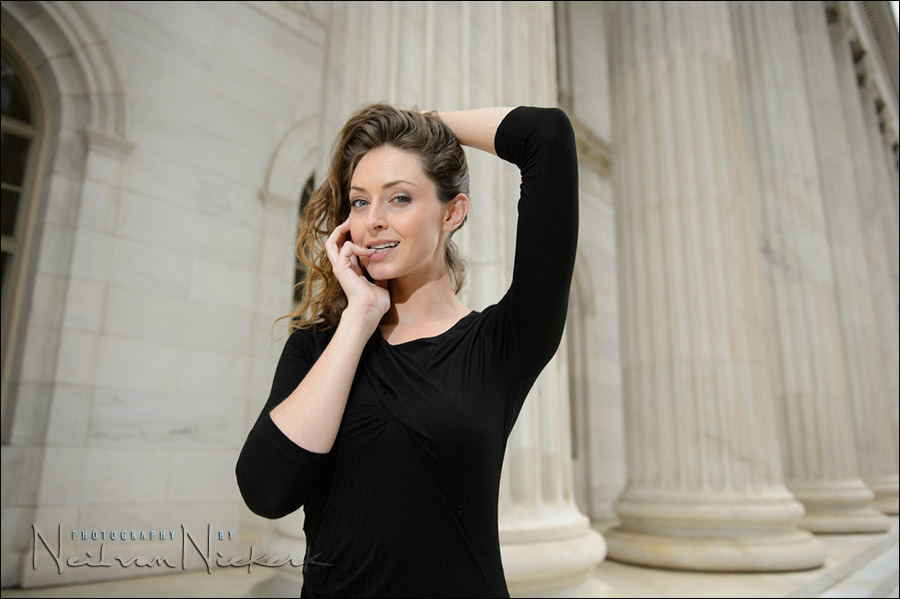
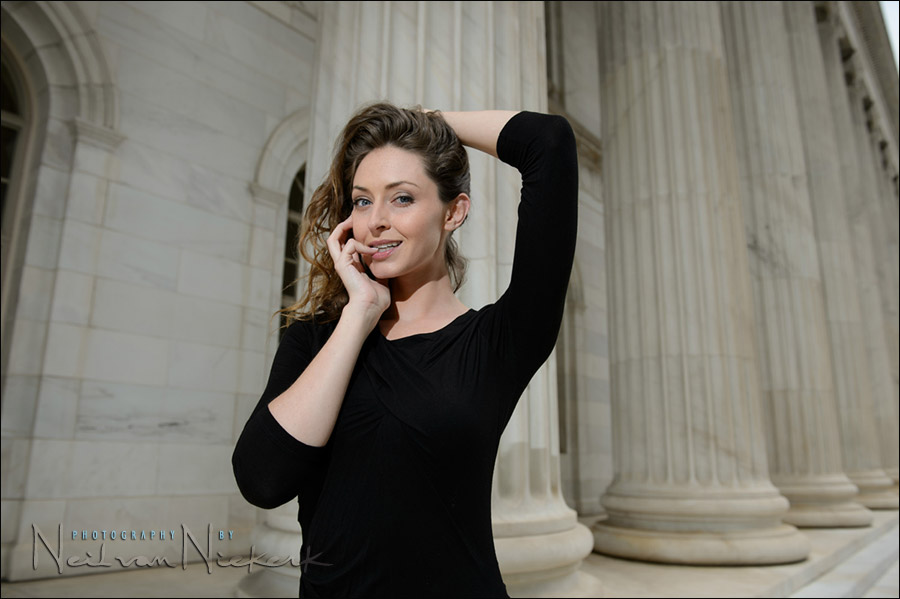
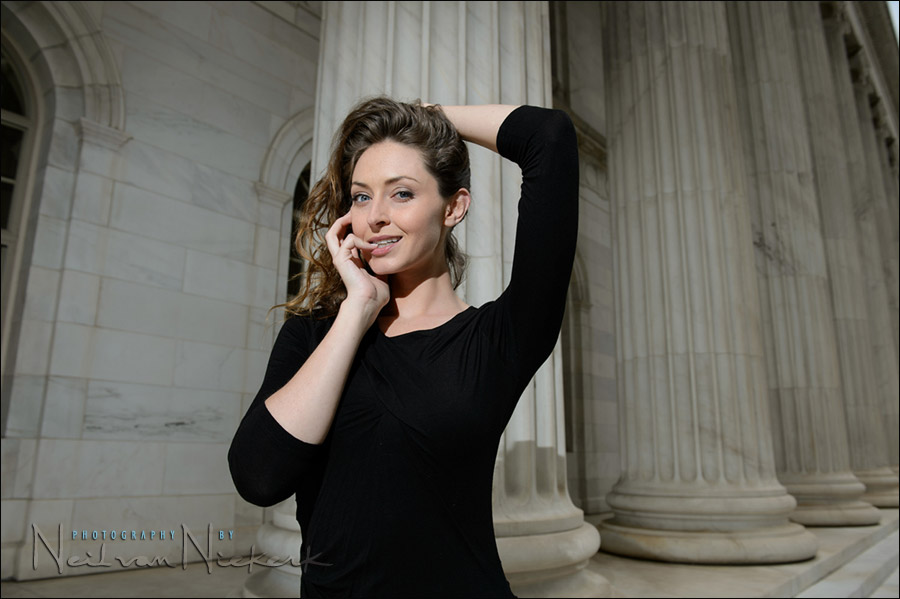
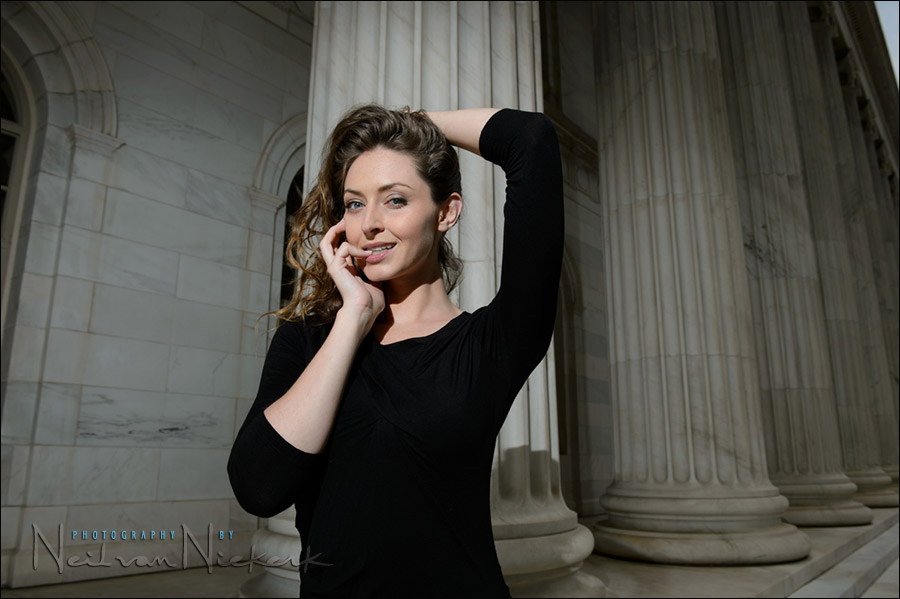
I had to pull down the f/2.8 exposure by 1/3rd stop in post and I had to pull up the f/8 exposure by 1/3rd stop in post. But you clearly see the difference here in how the change in aperture affected the ambient light. Since it is TTL flash, the flash followed, giving me (approximately) correct exposure. An easy, fast way to shoot.
So really, the decision on my camera settings, hinged on how dark I wanted my ambient light to appear in the image. I had choices. All of them good choices. It now becomes an artistic decision which I want to try.
The more dramatic effect is usually the more interesting choice.
Related articles
- Flash photography tutorial
- Manual flash vs TTL flash (model – Aleona)
- Various scenarios: Balancing flash with ambient light (model: Catherine)
- Flash photography tutorial: Balancing flash & ambient exposure (model: Anelisa)
- Controlling bright daylight w/ direct off-camera flash (model – Molly K)
- Using direct, bare (un-modified) off-camera flash (model – Lea)
- When aperture does NOT control flash exposure
Photo gear (and equivalents) used in this photo session
- Nikon D4
- Nikon 24-70mm f2.8G AF-S / Canon 24-70mm f/2.8L II
- Nikon SB-910 Speedlight / Canon 600EX-RT Speedlite
- Nikon SD-9 battery pack / Canon CP-E4 battery pack
- Manfrotto 1004BAC – tall light-stand
A little bit of homework
- With manual flash, what would’ve happened if I had changed my aperture between those 4 settings? f/2.8 to f/8
- If I had decided to change my shutter speed, what would the consequence be? (Work through the range of settings.)
- “aperture controls flash exposure / shutter speed controls ambient”
That’s the usual mantra. Why did it not apply here?

Hi Neil,
3 questions.
Am I correct assuming the day was overcast and the top image (f/2.8) out of the bottom series was underexposing ambient by 1-1.5 EV? Is this how you achieve this “pop”, this “separation” from the BG comparing to ambient only picture a bit lower?
I am really interested in mixing flash and ambient in a really subtle way, almost invisible and creating some interest at the same time. I’m assuming a “correct” ambient exposure & adding a flash would overexpose the model?
On the other hand – exposing “correctly” for the ambient on model and adding 1-2EV less flash – would you call it a fill flash? even though there was no shadows to fill in because of flat ambient light?
Thanks in advance.
Great article!
Sorry, hate to be “that guy”, but for the love of god, please don’t let your model do that “hand in hair” pose. It screams amateur model that doesn’t know what to do with their hands. If you have a beginner model that doesn’t know how to make her hands look relaxed, then give her a hand prop to work with.
When is the last time you have seen a chick standing on the steps of the courthouse doing all those weird gestures like in the picture?? It just looks silly.
When was the last time you saw an elegantly dressed woman between two elephants doing all those weird gestures?
Now tell me it looks silly, and I’ll find other examples where the subject in the photograph is doing something that someone in real life wouldn’t be doing. We could be here a while. More opportunity for you to be “that guy”.
Alternately, we could just go to your own website:
(Very solid work, btw!)
Manual flash would see the flash output go dimmer when stopping down. (global change)
Changing (slowing) shutter speed by the same amount (# of clicks) would have left the ambient the same in all photos.
The usual mantra does not work in E-TTL, only in Manual.
Really like the first photo from the sequence…well balanced exposure with good DoF
RC
Those elephants look silly posing like that with that nice women. Just saying…
Yup, and it bothers me tremendously that those (chained) elephants were brutalized into being performing animals.
Still, an iconic photograph.
Photography aside…
“Yup, and it bothers me tremendously that those (chained) elephants were brutalized into being performing animals.” this speaks volumes of your humanity Neil and I applaud you!
Really like the undiffused light, looks similar to a softbox light . How far was the off camera flash held?
Neil,
I know that the extent to which one drops the ambient exposure relative to the flash is a matter of personal taste. I have also read on this site that you often base this decision on the quantity and quality of the ambient light. My question, in regards to preserving a “natural” look to an image, is how much does the flash and flash modifier at your disposal factor into the equation. As an example, if you are strictly using on-camera bounce with the BFT, do you limit underexposing the ambient by a certain amount but will drop down further if using a softbox (or vice-versa)?
Just trying to gain a better understanding of how to make such decisions.
Great site! Very informative.
Fair enough and I was definitely not trying to put Neil down. I come to this site because there is great info and I appreciate the technical info. I was more relating my own experiences in working with models… Sometimes you get a great model that you barely have to coach at all and she knows all the right angles that work on camera and she looks totally relaxed… But when they start doing the model mayhem 101 poses it might be a good idea to give them some guidance ;)
Hi Neil,another brilliant article. I was reading an earlier post on engagement photography and you mention that in these situations you frequently use the Nikon 24-120 f4 VR. Could you please share your impressions of that lens? Iam considering picking one up as a walk around and travel lens but none of the reviews I’ve read so far give it glowing recommendations but not really bad ones either. I currently shoot the 24-70 and 70-200 f2.8 but they are really big and heavy for travel. Any insight you can offer would be greatly appreciated.
Thanks Neil.
Ross
Homework:
Q: With manual flash, what would’ve happened if I had changed my aperture between those 4 settings? f/2.8 to f/8
A: less light on the sensor which means darker images
Q: If I had decided to change my shutter speed, what would the consequence be? (Work through the range of settings.)
A: Darker or lighter ambient light
Q: “aperture controls flash exposure / shutter speed controls ambient”
That’s the usual mantra. Why did it not apply here?
A: Because you work in TTL mode.
I would love a more detailed piece on these homework questions if thatt is possible. Not quite grasping it
Work through the posts listed under “related articles” to fill in the missing pieces of the puzzle.